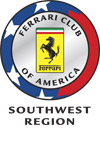
Tech Tip - Installing Six Point Harnesses
By: Marshall Buck
In order to bring our Ferraris up to the same standard as other cars used for rapid track driving, I believe we must equip them with 6 point harnesses for driver and passenger. Not only does this increase safety, it also provides a more "secure" feeling when cornering at high "G" forces and is a requirement for participation in FCA/Alfa track events in the Time Trial or Race groups.I have done this for my 308, without drilling holes in the car. Note: these harnesses strap you into the seat really firmly, therefore making it difficult to turn and look behind you for lane changes or backing up. It is recommended that you continue to use your factory Ferrari seat belts for street driving.
I purchased a FIA/SCCA legal 6 point harness system, which are available in many different styles. I got "camlock" style buckles but "latch" style are OK too. The system has two inch webbing for the anti-submarine straps with three inch webbing for the lap and shoulder harness. I got the individual shoulder harnesses, not the "Y" style. The anti-submarine straps were purchased with the slotted bracket with a bolt hole, although you may want the eyebolt clips here, for ease of removal. The lap belts had the clips for eyebolts and the shoulder harnesses simply had buckles (wrap-around style). Some manufacturers of these belts include Simpson, Stand 21, Luke, Diest, and AutoPower.
I found it very easy to attach the new lap belts to two eye hooks (provided with the belts) with which I replaced the stock bolts at the sides of the seats. The stock Ferrari threaded holes take standard 7/16 x 20 SAE bolts. I reattached the stock belts under the eyebolts.
 An example of lap belts with clip-on style ends. These are standard (non-camlock) Simpson models. They clip onto eyebolts (provided with belts) that thread into the standard seat belt anchor bolt holes.
An example of lap belts with clip-on style ends. These are standard (non-camlock) Simpson models. They clip onto eyebolts (provided with belts) that thread into the standard seat belt anchor bolt holes.
The anti-submarine belt brackets were attached with 7mm nuts and bolts to two small custom brackets, fabricated from 1/8 inch thick, 1 1/8 by 3 1/4 inch steel. If you choose to use the eyebolts here, drill 31/64 inch holes. Two 8mm clearance holes were drilled on the centerline 2 1/2 inches between centers. These brackets were then sandwiched between the front of the seat tracks and the floor. The stock socket head seat track hold down screws were reused.
A shoulder harness bar was fabricated from one inch O.D. 4130 Chrome Moly 0.120 inch wall tube. The ends were heated and flattened from one side, then normalized and the bar was power coated with satin black. 31/64 inch clearance holes were drilled 47 1/2 inches on center for the 7/16 x 20 Grade 8 bolts, 2 1/4 inches long, which were screwed into the stock shoulder harness attachment points. The tube was given a gentle bend, to conform to the curves in the Ferrari's interior, and powder coated satin black. Suitable spacers and washers were used, including two (optional) bushings (BMW part 72 11 1 813 915) under the tube ends to provide clearance for the stock shoulder harness clips, which were retained. I passed the shoulder webs around the bar, cinching them with the provided buckles. The loose ends were tied together to keep the harnesses six inches apart at the bar. Black tie wraps cinched around the bar keep them from sliding.
 An example of shoulder belts with wrap-around buckles. Again, these are Simpson standard style..
An example of shoulder belts with wrap-around buckles. Again, these are Simpson standard style..
The fire extinguisher may be mounted to the center of this bar, or preferably, mounted to a bracket which is fabricated to attach under the seat tracks at the front of the passenger seat.
The car is now much more suitable for high performance driving, and the stock belts have been retained for everyday tooling around. All this, without any
